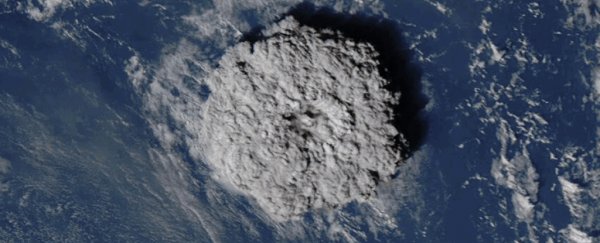It's official: after some careful data analysis, the Tonga volcano eruption of 2022 has been confirmed as the largest explosive eruption of the 21st century, and on par with the biggest eruptions ever recorded.
Having ejected material around 10 cubic kilometers (more than 2 cubic miles) in volume, generating an atmospheric shock wave that circled the world several times, and producing an ash plume half the size of France, the eruption was equivalent in strength to the cataclysmic 1991 eruption of Mount Pinatubo in the Philippines.
Researchers used a newly developed algorithm to identify the scale of the Tonga eruption, significantly cutting down on the amount of field work and direct measurements required. The Volcanic Explosivity Index (VEI) rating for the blast was set at 6, with one such eruption expected once every 50-100 years.
The VEI peaks at 8 – eruptions that occur every 50,000 years or so. We haven't had any of those for tens of thousands of years, scientists think, and these explosions can produce as much as 1,000 cubic kilometers (almost 240 cubic miles) of ejecta volume.
Having an algorithm like this has the potential to be incredibly useful, bearing in mind that a lot of eruptions happen in remote locations where there isn't a lot of equipment around to measure the event directly.
What scientists do now have is a vast network of hundreds of seismic monitoring stations; these can very quickly pick up reverberations in the ground, even across long distances. It's those seismic waves that this new approach uses to calculate eruption size.
Plus, the algorithm is able to estimate volcanic eruption size in as little as an hour if there's enough data available, which can help in assessing the size of the resulting ash cloud – and how that cloud might affect the environment around it.
The eruption in January 2022 – the Hunga Tonga–Hunga Ha'apai eruption, to give its full title – destroyed 90 percent of the uninhabited island of Hunga Tonga Ha'apai, which itself only emerged in 2015 after another, smaller eruption.
Experts think the way the volcano exploded directly into seawater rather than into the open air may have had something to do with the scale of the subsequent blast, and the strength and distance covered of the subsequent tsunamis as well.
"Despite the unprecedented wealth of high-quality and rapidly available scientific data, the main quantitative parameters of the Hunga Tonga volcanic eruption, such as its size in comparison with previous major eruptions, could not be estimated rapidly with 'standard' monitoring algorithms," write the researchers in their published paper.
"This emphasizes the need to develop new approaches for analysis of instrumental observations."
The researchers admit their algorithm amounts to a "simple framework" for now and one which can be refined in plenty of ways in the future.
However, it's already able to make calculations in real time without a huge amount of computational effort. As data on more eruptions are collected, the algorithm can be further improved.
The research has been published in Geophysical Research Letters.
